#queen consort of poland
Explore tagged Tumblr posts
Text

Elizabeth of Austria (1436-1505) Queen of Poland and Grand Duchess of Lithuania as the wife of King Casimir IV of Poland.
#haus habsburg#erzherzogin#archduchess#österreich#erzherzogtum österreich#house of habsburg#queen consort#queen consort of poland#Elżbieta Rakuszanka#elizabeth of austria#Elžbieta Habsburgaitė#elisabeth von habsburg#królestwo polskie#Jagiellonian dynasty#Jagiellonian#House of Jagiellon#dynastia jagiellońska#dynastia Jagiellonów
3 notes
·
View notes
Text








Royal Birthdays for today, January 17th:
Philip the Bold, Duke of Burgundy, 1342
Frederick III, Elector of Saxony, 1463
Stanislaus II Augustus, King of Poland, 1732
Maria Cristina of Naples and Sicily, Queen of Sardinia, 1779
Elisabeth Franziska, Archduchess of Austria, 1831
Marie Louise of Bourbon-Parma, Princess Consort of Bulgaria, 1870
Dibyalangkarn, Princess of Thailand, 1891
Mia Tindall, Granddaughter of Princess Anne, 2014
#philip the bold#mia tindall#Marie Louise of Bourbon-Parma#Elisabeth Franziska of austria#Maria Cristina of Naples and Sicily#Stanislaus II Augustus#Frederick III#princess Dibyalangkarn#royal birthdays#long live the queue
8 notes
·
View notes
Text
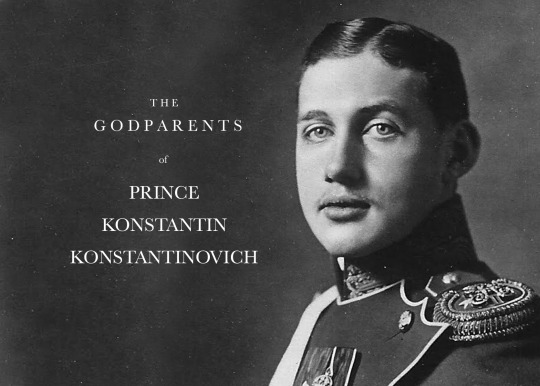
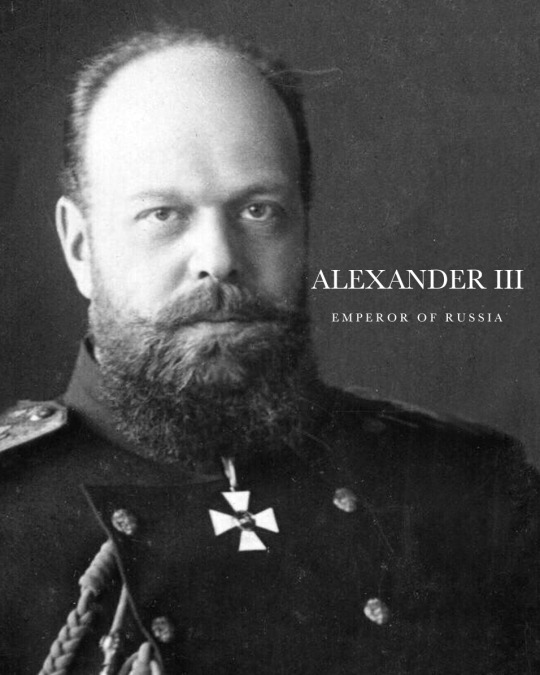




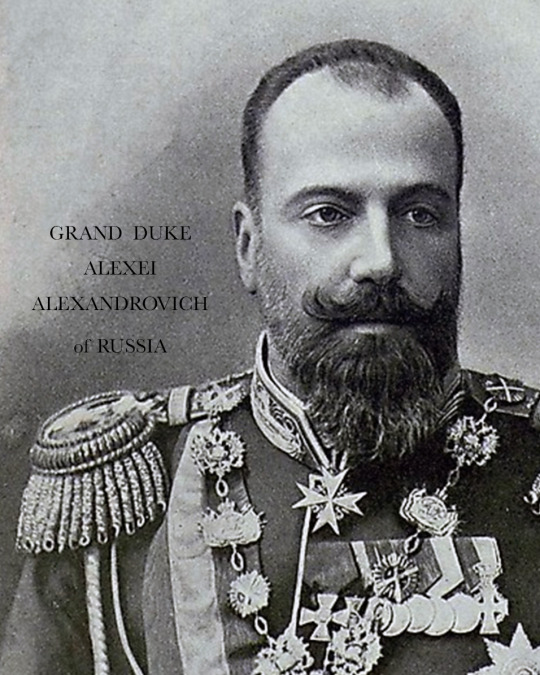

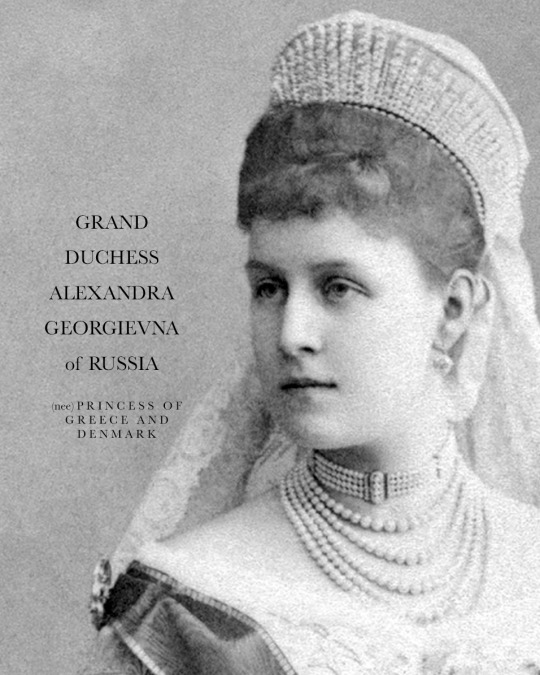
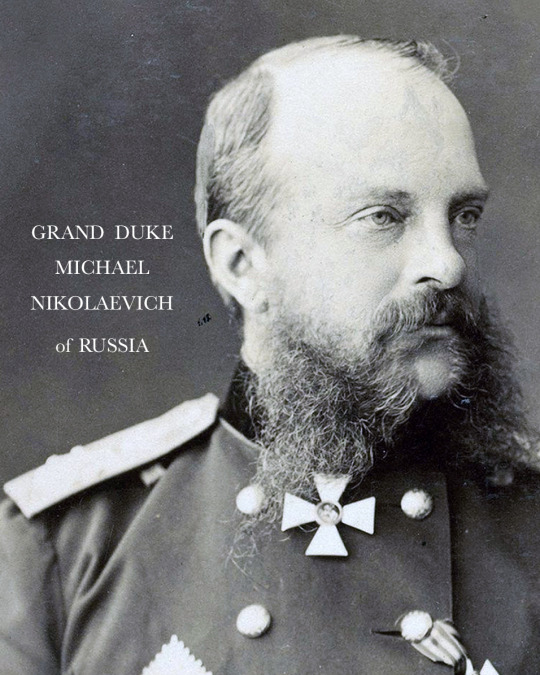



GODPARENTS OF PRINCE KONSTANTIN KONSTANTINOVICH
Prince Konstantin Konstantinovich was born on 1 January 1891 in Saint Petersburg, Imperial Russia. He was the third son and fourth child of Grand Duke Konstantin Konstantinovich of Russia and his German-born wife Grand Duchess Elizabeth Mavrikievna. Konstantin was christened on 3 January at 2 in the afternoon at Marble Palace Church, St. Petersburg, by the Confessor of Their Majesties. His godparents were:
ALEXANDER III, EMPEROR OF RUSSIA - his father’s first cousin was named as one of his many godparents. He was highly reactionary in domestic affairs and reversed some of the liberal reforms of his father, Alexander II. He was most likely present at his young cousin’s christening.
GRAND DUKE KONSTANTIN NIKOLAEVICH OF RUSSIA - his paternal grandfather and namesake was one of his numerous godparents. He was the Viceroy of Poland from 1862 to 1863. His real influence on internal affairs after 1868 was insignificant. He was reportedly absent at his grandson's christening, due to his ill health.
CHARLES ALEXANDER, GRAND DUKE OF SAXE-WEIMAR-EISENACH - his parents' distant cousin (as a grandson of Emperor Paul I of Russia) was also named as the young Konstantin's godparent. He was absent at the prince's christening. He was the penultimate ruler of Saxe-Weimar-Eisenach, from 1853 until his death in 1901.
QUEEN MARIE OF HANOVER - his great-aunt, the last Queen consort of Hanover, was amongst his numerous godparents. She was absent at his christening.
ELISABETH, GRAND DUCHESS OF OLDENBURG - another of his great-aunt named as his godmother. Elisabeth, upon her marriage to the Grand Duke of Oldenburg used the funds given to her by her father to set up the Elisabeth Foundation, which still exists today. Like her sister Queen Marie, she was absent at her great-nephew's christening.
GRAND DUKE ALEXEI ALEXANDROVICH OF RUSSIA - his father's illustrious first cousin was named as the prince's godfather. Chosen for a naval career, Alexei started his military training at an early age. By the age of 20 he had been appointed lieutenant of the Imperial Russian Navy, eventually becoming general-admiral.
GRAND DUCHESS ALEXANDRA PETROVNA OF RUSSIA - his great-aunt, the wife of Grand Duke Nicholas Nikolaevich, was another of his godmothers.A plain, and serious woman, her marriage to Grand Duke Nicholas was an unhappy one. Nevertheless, she would enjoy and maintain a good relationship with a few of her nephews including Emperor Alexander III and Grand Duke Konstantin Konstantinovich, who were sympathetic to her.
GRAND DUCHESS ALEXANDRA GEORGIEVNA OF RUSSIA - his paternal first cousin, the eldest daughter of King George I and Queen Olga, had been present and named as a godparent of Prince Konstantin, who was merely nineteen years her senior. In 1889, she married Grand Duke Paul Alexandrovich, the youngest brother of Emperor Alexander III.
GRAND DUKE MICHAEL NIKOLAEVICH OF RUSSIA - his great-uncle was also listed as his godparent, and had been present at the christening. A soldier for most of his adult life, he enjoyed a favourable relationship with the three last Emperors of Russia - his brother Alexander II; nephew Alexander III; and great-nephew Nicholas II.
GRAND DUKE PETER NIKOLAEVICH OF RUSSIA - his father's first cousin was another of his many godparents. He was the younger son of Grand Duke Nicholas Nikolaevich and his wife grand Duchess Alexandra Petrovna (also named as a godparent of Prince Konstantin, listed above).
PRINCESS AUGUSTA OF SAXE-MEININGEN - his maternal grandmother was also named as his godmother. In 1862, she married Prince Moritz of Saxe-Altenburg, and bore him five children.
PRINCESS LOUISE CHARLOTTE OF SAXE-ALTENBURG - his maternal aunt, the youngest sister of Grand Duchess Elizabeth Mavrikievna was amongst his numerous godparents. Both Louise Charlotte and her mother Augusta were absent at Konstantin's christening.
Source
48 notes
·
View notes
Note
Since you got so many postive reactions, I'll also add something Your story is boring. Its too long, its too complicated, the plot is too long, nothing happens, it's not RA at all any more, it has nothing to do with canon! Halt is a joke, there is nothing left of him. This is annoying, the whole story is annoying! Secondly, you dramatize the story too much. Why is Halt's mother a child when she gave birth to him? Don't you have enough angst from the plot, then you have to add such elements and make the king a pedo? A bit pathetic, if you ask me. Why is she so young? Why would Caitlyn be married so young? Nobody did that in the canon! Second, why, for God's sake, is everyone there gay? In the Middle Ages? What's that supposed to be? Third, you don't respect your own readers. You post new chapters without any rhythm, once every week, once every month, instead of sticking to any routine. People don't want to read something so inconsistent, it's stupid, it's annoying. Oh and all those references to Catholicism in the plot in and your made up religion. Is it really necessary?
It's a shame, because this could have been a really cool story… you still have a lot to learn, good luck!
Hello, I would say thanks for contacting, but then it would probably sound ironic. Well.
I understand that the pace of the story may not suit everyone, especially people who prefer short stories. However, I made it clear from the outset that the story would be long and complex. It's a whole AU and yes, I love worldbuilding and I won't apologise for that. I care about the details, but I also care about a balanced sinusoid of action. This isn't an action movie where you'll eat popcorn and laugh at the jokes, it's a marathon geared towards experiencing the story a little deeper. If it annoys you, I'm not sure why you don't just give up reading it…. you refer to the facts revealed in recent chapters, so you've at least made it to chapter 41, even though the story annoys you so much. Why? And why should it be my fault?
Let the numbers speak for me. Jadwiga Andegaweńska, King of Poland, married Władysław Jagiełło, Grand Duke of Lithuania, at the age of 12. He was 35 years old at the time. He took his last wife at the age of 70. She was named Zofia Holszańska, she was 17. Henry VIII of England took Catherine Howard as his wife when she was 17. He was 49. The youngest queen consort was Isabella of Valois, second wife of Richard II, aged 6 years 11 months and 25 days when she was married to him in 1396. The average age at which women were given in marriage in the Middle Ages was 12-14 years. It was only at the end of this era that this age changed to the late teens (16-19). The Renaissance brought a shift in this average to the early 20s. Yes, I am aware that we do not have such situations in the canon. Probably because the canon is a conglomeration of several different visions of the Middle Ages, which the author did not see fit to separate. Armaments, schooling, lack of illiteracy, developed medicine and finally, social realities all disagree. I am sorry to have to tell you this, but no princess married a plebeian knight because he was nice and she loved him. No princess ran around in the woods with a slingshot and none of them was likely to be allowed to become a super secret special task soldier because her parents couldn't cope with her upbringing. Canon has nothing to do with historical reality. In many ways it also misses the mark with my story. It's a fanfic. It's just a story, invented by me and loosely based on canon. It's AU - Alternative Universe. Where there's magic, religious wars and various things like that. But some of the stuff in there comes as a result of my fascination with history and the development of societies in different eras. Hence, certain phenomena, such as just the treatment of women, the age at which they were given in marriage, illiteracy, pestilence, economic dualism and sending children to war, appear in the storyline. Eileen is a monument to women, girls who were given in marriage to bear children to kings, to endure their outbursts of anger, beatings, rape and other forms of violence. Her story is very important to me and no, it is not there just to add drama. I'm sorry you see it that way.
Because we are human, we have always existed and we will always exist. Because it is a story written by a queer person and because as an author I can do so. I also pointed this out in the tags. Too many queer people reading books couldn't find themselves in the plot. I only write queer stories. And if in a story about blood magic, prophecies, human sacrifice, violence, wars and betrayals, you have the biggest problem to a few queer people in the plot, it's no longer my fault.
Listen, I'm really trying not to be mean. Let me say this as gently as I can. I'm not your friend. I'm a random stranger on the internet that you know nothing about. I'm not your school mate for you to talk to me like that. I'm an adult, I work full time, I'm writing my Master's thesis and I'm taking care of two children. I'm sorry that my few hours a week that I can spend doing something for myself, are not enough for me to write a 16-19k chapter once a week. How annoying and mean of me. Wow.
I wasn't inspired by Catholicism. But it's interesting that of all the world religions, this is the one that came to your mind. If you associate a fictional religion based on blood sacrificing, heroising self-harm and sacrificing children, cruelty to captives and hateful contempt for women with Catholicism, then who am I to argue.
It's been so much fun writing to you. And you don't offend me by saying I have a lot to learn. We all have. If one stops learning, one dies. And I still have a whole lot of queer, boring, annoying stories to write. Have a lovely day! And may your toilet seat be cold af at the middle of the night :)
#rangers apprentice#ranger's apprentice#rangers apprentice fanfiction#the iron song fic#queer pride#historical inaccuracies
12 notes
·
View notes
Text

Queen Maria Amalia of Saxony
Artist: Giuseppe Bonito (Italian, 1707-1789)
Date: c. 1744
Medium: Oil on Canvas
Collection: Museo del Prado, Madrid, Spain
Maria Amalia of Saxony
Maria Amalia (Maria Amalia Christina Franziska Xaveria Flora Walburga; 24 November 1724 – 27 September 1760) was Queen of Spain from 10 August 1759 until her death in 1760 as the wife of King Charles III. Previously, she had been Queen of Naples and Sicily since marrying Charles on 19 June 1738. She was born a princess of Poland and Saxony, daughter of King Augustus III of Poland and Princess Maria Josepha of Austria. Maria Amalia and Charles had thirteen children, of whom seven survived into adulthood. A popular consort, Maria Amalia oversaw the construction of the Caserta Palace outside Naples as well as various other projects, and she is known for her influence upon the affairs of state.
Charles III described Maria Amalia of Saxony (1724-1760) as possessing the wit of an angel , and felt himself to be the happiest and most fortunate man in the world . The portrait of his young wife reflects his affectionate words and the complicity between the married couple, since appearing in it is the crown that Charles wore in Palermo on the day of his enthronement as King of Naples and Sicily. (Museo del Prado)
#portrait#oil on canvas#crown#wreath#costume#earrings#bracelet#giuseppe bonito#italian art#spanish culture#spanish queen#queen maria amalia of saxony#spanish monarchy#18th century
3 notes
·
View notes
Text
Another one from my diploma. It’s quite old already and I think I’ll draw them all again, haha.
Marie Casimire Louise de La Grange d'Arquien (28 June 1641 – 30 January 1716), known also by the diminutive form "Marysieńka", was a French noblewoman who became the queen consort of Poland and grand duchess consort of Lithuania from 1674 to 1696 by her marriage to King and Grand Duke John III Sobieski of the Polish–Lithuanian Commonwealth.

Portraits of her under the cut:
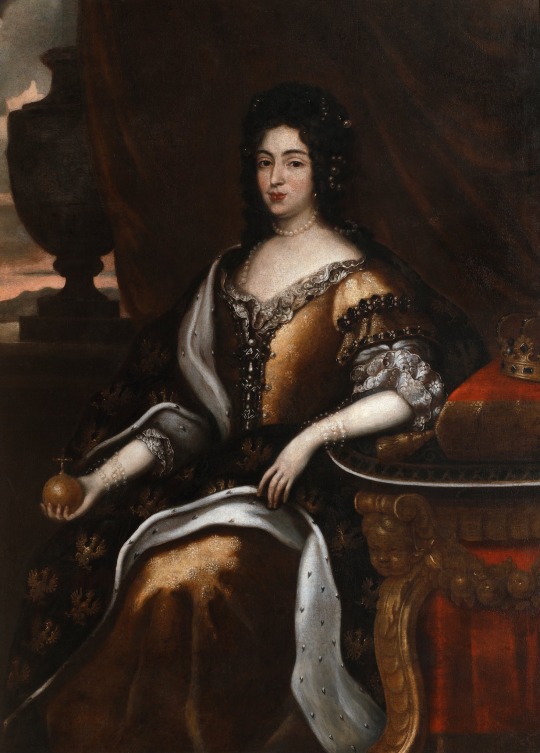
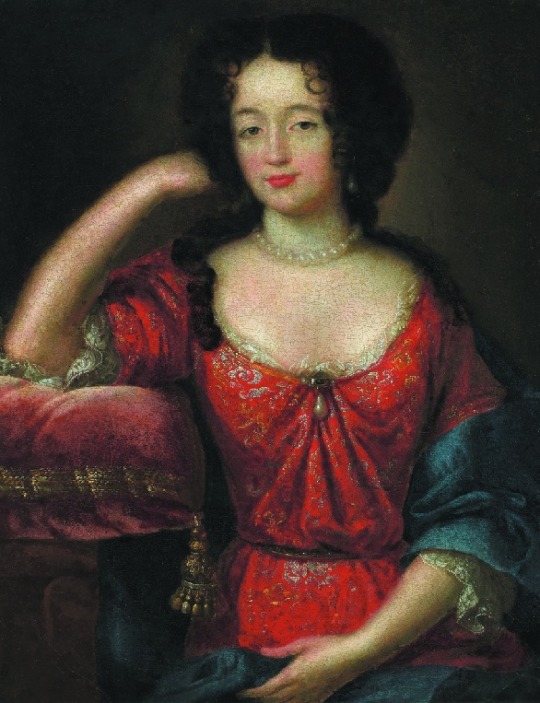

20 notes
·
View notes
Photo
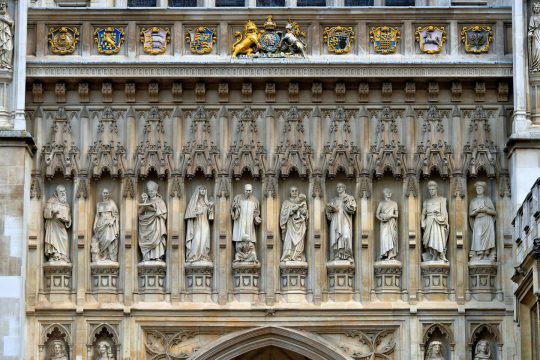

Quid est martyrium? Mortem pati pro Christo. Quid est Christianum? Christum sequi*
- St. Augustine
What is martyrdom? To suffer death for Christ. What is a Christian? To follow Christ.*
After the restoration of the western towers of the Abbey had been completed in 1995, it was decided to fill the 10 gothic niches above the west doorway with statues. The lower part of the towers date from the 15th century and the tops of the towers were completed in 1745. The niches never had statues, although this was obviously the plan of decoration.
It was decided to use the ten niches not just to commemorate saints or worthy figures from the past. So instead of traditional figures of kings or saints, the abbey decided that martyrs of the 20th century should be remembered. The West entrance was to proclaim a message of which too few people are aware: the 20th century was a century of Christian martyrdom. Although the statues are of individual martyrs they are intended to represent all those others who have died (and continue to die) in similar circumstances of oppression and persecution. Their statues were drawn from every continent and many Christian denominations.
Four sculptors completed the statues, carved from French Richemont limestone. The Archbishop of Canterbury, George Carey, unveiled the statues in July 1998 at a service attended by HM Queen Elizabeth II.

The ten Christian modern martyrs are (from left to right):
Maximilian Kolbe: a Catholic priest who helped Jews in Poland and who died in Auschwitz in 1941 after offering to take the place of a condemned man.
Manche Masemola: a 16-year-old girl from South Africa who was killed by her parents in 1928 when she converted to Christianity.
Janani Luwum: the Archbishop of Uganda who was murdered on the orders of Idi Amin in 1977.
Grand Duchess Elizabeth Feodorovna: a member of the Russian Imperial family (by marriage) who founded a convent but was murdered by the Bolsheviks during the Russian Revolution.
Martin Luther King: the American civil rights campaigner who was murdered in 1969.
Oscar Romero: the Archbishop of San Salvador, murdered by a death squad in 1980.
Dietrich Bonhoeffer: a Lutheran theologian who was implicated in the bomb plot against Adolf Hitler and executed in 1945.
Esther John: a Pakistani nurse and Christian evangelist who was murdered by a Muslim relative in 1960.
Lucian Tapledi: an Anglican in New Guinea who was killed by invading Japanese troops in 1942.
Wang Zhiming: a Christian pastor in China who was executed in 1973 during the Cultural Revolution.
In June 1953, during Her Late Majesty Queen Elizabeth II’s coronation, she entered through the west door of London’s Westminster Abbey. During her arrival, she was received by massed choirs singing “I was glad when they said unto me, we will go into the house of the Lord” (Psalm 122, 1-3,6, 7.)
On 6 May, King Charles III and Queen Consort Camilla will be crowned at Westminster Abbey. For many, this will be the first coronation they have ever seen. The ceremony will follow a pattern laid out in the Liber Regalis, kept at Westminster Abbey and which has informed the pattern of coronations since the 14th century. The service which will see the Coronation of King Charles and Queen Camilla will include the same elements as the historic coronations which have gone before and everything starts with their entry to the Abbey. This means King Charles III will enter the Abbey through the West door and under the statues of these 10 Christian modern martyrs.
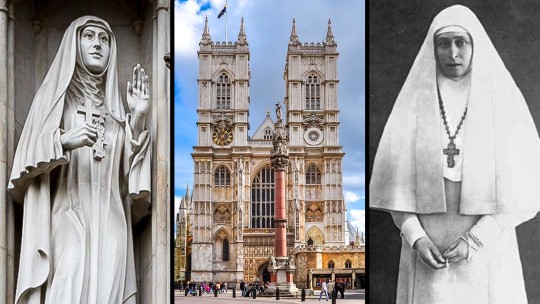
For King Charles III it will have a particular personal resonance as he will walk under the soulful gaze of his great-great aunt through his father’s side (the late Prince Phillip, Duke of Edinburgh), Grand Duchess Elizabeth Feodorovna.
Elizabeth of Hesse-Darmstadt was born on 1 November 1864. Her mother died when she was a child, and she came to England to live with her grandmother, Queen Victoria. Her childhood was Lutheran and her adolescence was Anglican. Elizabeth married Grand Duke Sergei Alexandrovich, the fifth son of Tsar Alexander II of Russia in 1884, and joined the Orthodox Church in 1891.
When her husband was assassinated in 1905, she gave away all her jewellery, sold her most luxurious possessions, and opened the Martha and Mary home in Moscow. Elizabeth and 17 of her companions formally became nuns in 1909. They soon opened a hospital and began other philanthropic works.
The Tsarist state collapsed in March 1917, and the Bolsheviks seized power in October 1917. Elizabeth was arrested with two sisters from her convent on 7 May 1918, and transported across country to Perm, then to Ekatarinburg, and finally to Alapaevsk. On 17 July, the Tsar and his family were shot dead. During the following night, Elizabeth, Sister Varvara, and members of the royal family were murdered in a mineshaft. Elizabeth was recognised as a saint by the Russian Orthodox Church Abroad in 1984 and by the Moscow Patriarchate in 1992.

Had there been more than ten niches available, there would have been other candidates available for inclusion in Westminster Abbey. As it stands, this memorial makes a powerful statement about the fact that people are still dying for their Christian beliefs in the present age. Although most cathedrals only seem to commemorate people who are long-dead and long-forgotten, Westminster Abbey bucked the trend in a dramatic and highly poignant way.
#st augustine#augustine#quote#westminster abbey#martyrs#martyrdom#christianity#west door#modern martyrs#statues#coronation#king charles III#monarchy#cathedral#church#faith#heritage#custom#tradition#christian#society#britain#england
51 notes
·
View notes
Text
I just saw a fic on Spacebattles 'Worm 1621' which puts the Wormverse in the year 1621/The Early Modern Period. Very interesting concept, haven't read it yet, but at the front, the author put a section of where all the various characters in Worm are. Vicky is the Queen Consort of Poland, of all things, and Marquis is the King of France.
Panacea is the princess of france, and the notation specifically says "worshipped as a holy figure."
Which makes sense, her power in that era absolutely would have her be seen as some sort of living saint type person for a lot of people, even if the Catholic Church as an institution may not be onboard (though perhaps in-universe the Church has officially ruled heroic parahumans to be touched by god or w/e, again, haven't started the fic yet, it's up on the list)
But I read that and I'm like... way to torment our girl Amy right? Because I'm pretty sure, especially given @mechakingghidorah100-blog's really good points about what an Amelia raised by Marquis might be like on this post (which I mostly agree with), Amy would still be fairly introverted and socially awkward, even if probably better at faking it for public functions.
So she would absolutely hate being an icon of religious worship. And while I doubt, going from the summary of the work (and the fact that it's been dead since 2016) Amelia/Panacea shows up much or at all, it's a hilarious idea.
And like, when you think about it, the fact that there don't seem to be any people worshipping Panacea, even a tiny number, in canon, is weird (though really, the lack of parahuman cults outside of the Fallen in general is a bit off. Wildbow really doesn't do a lot with religion in Worm. Function of who he is, when he wrote it and intended audience probably)
If there's one way to make any version of Amy suffer, but especially the canon Amy Dallon 'i'm evil and a freak because of my villain dad and my crush on my sister and the fact that I hate healing' a cult worshipping her as Panacea, the miracle cure all living saint would definitely be a great (and fun) way to do it.
Granted, I am going to subject Amy to something like that whenever I write my Dragon Age: Inquisition/Worm crossover starring Amy (that my little Panacea-Quistion oneshot was a notional epilogue to), but still.
More fics where Amy gets tormented by people trying to worship her please! :P
6 notes
·
View notes
Text
Infanta Mariana Vitória of Spain, Queen Consort to José I of Portugal
A Bourbon who was supposed to marry Louis XV of France, but ended up with a distaste towards the French Court. She was Regent of Portugal from 1775-1776. When her daughter took the throne in 1777, Mariana Vitóia helped to manage the relationship between Spain and Portugal.

Vs.
Infante Manuel, Count of of Ourém and candidate for the throne of Poland in 1733 (supported by Prussia, Austria, and Russia)
He was known for his bohemian lifestyle visiting European Courts. Following his excursion in Poland focused on artists and musicians his return to Portugal when he was not chosen for the Polish throne.

#a casa de bragança#the house of braganza#the house of bragança#best braganza bracket#best bragança bracket
8 notes
·
View notes
Text
Day 8: Anne of Bohemia and Hungary
Anne of Bohemia and Hungary (also known as Anna Jagellonica)
Born: 23 July 1503 Died: 27 January 1547
Parents: Vladislaus II of Hungary and Anne of Foix-Candale Archduchess Consort of Austria, Queen Consort of Hungary, Bohemia and Croatia Children: Elizabeth, Queen of Poland Maximilian II, Holy Roman Emperor Anna, Duchess of Bavaria Ferdinand II, Archduke of Austria Maria, Duchess of Jülich-Cleves-Berg Archduchess Magdalena Catherine, Queen of Poland Eleanor, Duchess of Mantua Archduchess Margaret Barbara, Duchess of Ferrara Charles II, Archduke of Austria Archduchess Helena Joanna, Grand Duchess of Tuscany
Anna of Bohemia and Hungary was the oldest child and only daughter of Vladislaus II of Hungary and his third wife Anne of Foix-Candale. Her younger brother was the King of Hungary, Croatia and Bohemia. On her father’s side, her grandparents were Casimir IV of Poland and Elisabeth of Austria. On her mother’s side her grandparents were Gaston de Foix, Count of Candale, and Catherine de Foix.
She was born in Buda (actualmente Budapest) Her mother died shortly after her brother’s birth. Their father died on 13 March 1516 and the two siblings were left in the care of the Holy Roman Emperor Maximilian I. Maximilian arranged for Anne to marry his grandson, Archduke Ferdinand of Austria.
Anne received a humanist education focused on problem-solving skills. There was also an emphasis on self-defense with weapons and other physical skills and hunting. She was instructed in music and dance and came into contact with many humanists visiting the imperial library.
On 26 May 1521 in Linz, Austria, Anne and Ferdinand were married. Ferdinand governed Habsburg hereditary lands on behalf of his older brother Charles V, Holy Roman Emperor. It was stipulated that if Anne’s brother died without heirs, Ferdinand would succeed him.
On 29 August 1526, Louis was thrown off his horse at the Battle of Mohács against Suleiman the Magnificent. As he had no legitimate heir the thrones of Hungary and Bohemia were left vacant. Ferdinand quickly claimed them. He was elected king with Anne as his queen on 24 October 1526.
Hungary, on the other hand, was a different matter. Ferdinand was proclaimed king by a small group of nobles, but another group did not want a foreign ruler so they elected John Zápolya as an alternative king. The conflict that resulted lasted until 1570 when the Treaty of Speyer was signed in favor of Anne’s son Maximilian.
In 1531, Ferdinand’s brother Charles V elected him as his successor and was to be proclaimed King of the Romans after his death.
Anne was trusted by her husband, serving as regent in his absence and presiding over matters of great importance. She became renowned for her charity and wisdom.
All 15 of their children were born in Bohemia or Austria.
She died on 27 January 1547, aged 43, in Prague, after the birth of her last daughter.
#1500s#16th century#house of habsburg#women history#history#women in history#reinessance#hungary#austrian history
4 notes
·
View notes
Photo

Maria Amalia Christina Franziska Xaveria Flora Walburga of Saxony (24 November 1724 – 27 September 1760) was Queen of Spain from 10 August 1759 until her death in 1760 as the wife of King Charles III. Previously, she had been Queen of Naples and Sicily since marrying Charles on 19 June 1738. She was born a princess of Poland and Saxony, daughter of King Augustus III of Poland and Princess Maria Josepha of Austria. Maria Amalia and Charles had thirteen children, of whom seven survived into adulthood. A popular consort, Maria Amalia oversaw the construction of the Caserta Palace outside Naples as well as various other projects, and she is known for her influence upon the affairs of state.
#Maria Amalia Christina Franziska Xaveria Flora Walburga of Saxony#Maria Amalia of Saxony#House Wettin#XVIII century#people#portrait#paintings#art#arte
18 notes
·
View notes
Text
Court Circular | 23rd March 2023
Buckingham Palace
His Excellency Mr Yannis Tsaousis was received in audience by The King today and presented the Letters of Recall of his predecessor and his own Letters of Credence as Ambassador from the Hellenic Republic to the Court of St James’s. His Excellency Mr Koray Ertas was received in audience by The King and presented the Letters of Recall of his predecessor and his own Letters of Credence as Ambassador from the Republic of Turkey to the Court of St James’s. Mrs Ertas was also received by His Majesty. Sir Philip Barton (Permanent Under-Secretary of State for Foreign, Commonwealth and Development Affairs) was present. The King this afternoon officially opened the new London Headquarters of the European Bank for Reconstruction and Development at Five Bank Street, London E14, and was received by Colonel Jane Davis (Vice Lord-Lieutenant of Greater London), the President of the Bank (Mrs Odile Renaud-Basso) and Mr Peter Curwen (the Board Director representing the United Kingdom). His Majesty toured the Bank, escorted by the President, and met Ukrainian and Turkish staff before viewing an art exhibition of paintings from Ukraine and joining a Meeting with the Board of Directors on green transition. Mrs Derek Cross was later received by The King upon relinquishing her appointment as The late Queen’s Diary Secretary. The King was represented by The Duke of Kent at the Service of Thanksgiving for Field Marshal the Lord Inge KG (formerly Chief of the Defence Staff) which was held at St Margaret’s Church, Westminster Abbey, today. The Queen Consort was represented by General Sir Patrick Sanders.
Kensington Palace
The Prince of Wales today undertook the following engagements in Poland. His Royal Highness this morning laid a wreath at the Tomb of the Unknown Soldier at Plac Marszalka Józefa Pilsudskiego, Warsaw. The Prince of Wales afterwards called upon The President of the Republic of Poland at the President’s Chancellery, Warsaw. His Royal Highness this afternoon met Ukrainian refugees who are settled in the Polish community at Hala Koszyki, Koszykowa 63, Warsaw. The Prince of Wales subsequently met Ukrainian staff at Hala Koszyki who have been displaced from the British Embassy in Kyiv. His Royal Highness later arrived at Royal Air Force Northolt from Poland. Mr Jean-Christophe Gray, Mr Lee Thompson and Commander Robert Dixon RN were in attendance.
St James’s Palace
The Duke of Edinburgh, Patron, The Duke of Edinburgh’s International Award Foundation, this morning chaired a Trustees’ Meeting at 7 More London Riverside, London SE1.
St James’s Palace
The Princess Royal this morning visited Viridor Waste Management’s Dunbar Energy Recovery Facility in Oxwellmains, Dunbar, and was received by His Majesty’s Lord-Lieutenant of East Lothian (Mr Roderick Urquhart). Her Royal Highness, President, Scotch Chef’s Club, today visited the Monitor Farm Scotland Programme at J. R. B. Wilson and Sons, Cowbog Farm, Morebattle, Kelso, Roxburghshire, and was received by Mr John Jeffery (Deputy Lieutenant of Roxburgh, Ettrick and Lauderdale).
Kensington Palace
The Duchess of Gloucester, Royal Colonel, 7th Battalion The Rifles, this evening attended the Rededication Service of Queen Victoria’s Rifles’ Book of Remembrance at the Parish Church of St. George, Hanover Square, Lodon W1.
#court circular#princess anne#princess royal#king charles iii#prince william prince of wales#prince edward duke of edinburgh#birgitte duchess of gloucester#prince edward duke of kent#british royal family
14 notes
·
View notes
Text









Royal Birthdays for today, June 21st:
Bolesław V, High Duke of Poland, 1226
Maria of Austria, Holy Roman Empress, 1528
Maria Francisca of Savoy, Queen of Portugal, 1646
Benedetto, Duke of Chablais, 1741
Josepha of Fürstenberg-Weitra, Princess consort of Liechtenstein, 1776
Augusta of Bavaria, Duchess of Leuchtenberg, 1788
Tshering Yangdon, Queen Mother of Bhutan, 1959
William, Prince of Wales, 1982
Ferdinand, Archduke of Austria, 1997
#prince william#Tshering Yangdon#augusta of bavaria#Maria Francisca of Savoy#maria of austria#Josepha of Fürstenberg-Weitra#prince benedetto#Bolesław V#archduke ferdinand#long live the queue#royal birthdays
8 notes
·
View notes
Text







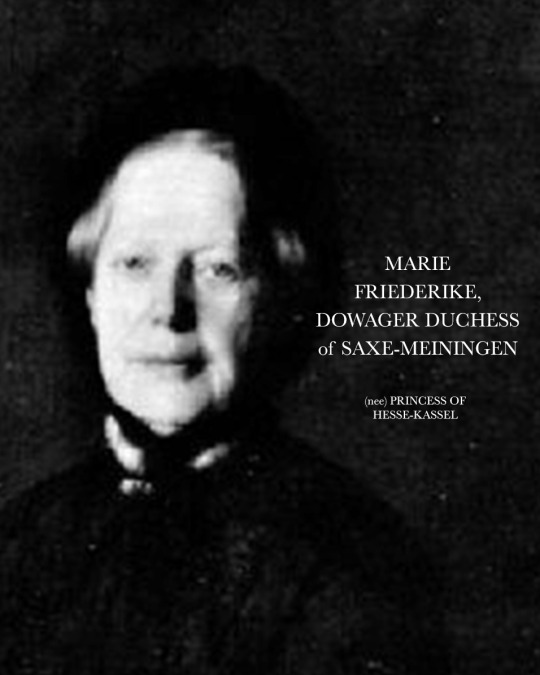

GODPARENTS OF PRINCE IOANN KONSTANTINOVICH
Prince Ioann Konstantinovich was born on 5 July 1886 in Pavlovsk Palace, Saint Petersburg. He was the eldest son of Grand Duke Konstantin Konstantinovich of Russia and his German-born wife Grand Duchess Elizabeth Mavrikievna. He was christened on 23 July at 1:30 in the afternoon in Strelna by the Confessor of Their Imperial Majesties, Archpriest Yanyshev. His godparents were:
ALEXANDER III, EMPEROR OF RUSSIA - his father's first cousin was named as one of his numerous godparents. He was highly reactionary in domestic affairs and reversed some of the liberal reforms of his father, Alexander II. He was absent at his young cousin's christening.
GRAND DUKE KONSTANTIN KONSTANTINOVICH OF RUSSIA - his paternal grandfather was one of his numerous godparents. He was the Viceroy of Poland from 1862 to 1863. His real influence on internal affairs after 1868 was insignificant.
PRINCE MORITZ OF SAXE-ALTENBURG - his maternal grandfather was another of his numerous godparents. He was of Romanov descent, through his grandmother Grand Duchess Elena Pavlova of Russia (daughter of Emperor Paul I).
GRAND DUCHESS OLGA NIKOLAEVNA OF RUSSIA, QUEEN CONSORT OF WÜRTTEMBERG - his great-aunt was one of his many godparents. She was the older sister of his grandfather Grand Duke Konstantin. Attractive, cultured and intelligent, she had been considered to be one of the most eligible princesses in Europe. In 1846, she married Crown Prince Karl of Württemberg. She was absent at the christening of his great-nephew.
GRAND DUCHESS OLGA KONSTANTINOVNA OF RUSSIA, QUEEN CONSORT OF GREECE - his paternal aunt was another of his godparents. In 1867, she married King George I of Greece (born a Danish prince), and had many children. As Queen, she was a popular figure and became involved in social and charitable work.
ERNST I, DUKE OF SAXE-ALTENBURG - his maternal great-uncle was listed as one of his godparents. In 1853 he succeeded his father as Duke of Saxe-Altenburg. He was of a retiring disposition and he took little active part in running the country.
MARIE FRIEDRIKE, DOWAGER DUCHESS OF SAXE-MEININGEN - his maternal great-grandmother was one of his godparents. Born a Princess of Hesse-Kassel, she married the Duke of Saxe-Meiningen, with whom two children (seventeen years apart) were born.
MARIE ANNE, HEREDITARY PRINCESS OF SCHAUMBURG-LIPPE - his maternal aunt, the favourite sister of his mother, was also named as one of his godparents. In 1882, she married the Hereditary Prince of Schaumburg-Lippe with whom she had nine children.
Source
13 notes
·
View notes
Text

Portrait of Maria Amalia of Saxony
Artist: Francesco Liani (Italian, 1712-1770)
Date: 1759
Medium: Oil on Canvas
Maria Amalia of Saxony
Maria Amalia (Maria Amalia Christina Franziska Xaveria Flora Walburga; 24 November 1724 – 27 September 1760) was Queen of Spain from 10 August 1759 until her death in 1760 as the wife of King Charles III. Previously, she had been Queen of Naples and Sicily since marrying Charles on 19 June 1738. She was born a princess of Poland and Saxony, daughter of King Augustus III of Poland and Princess Maria Josepha of Austria. Maria Amalia and Charles had thirteen children, of whom seven survived into adulthood. A popular consort, Maria Amalia oversaw the construction of the Caserta Palace outside Naples as well as various other projects, and she is known for her influence upon the affairs of state.
#portrait#seated#half length#woman#maria amalia of saxony#francesco liani#italian painter#queen of spain#18th century painting#historical#european#spanish royalty#column#indoors#costume#spanish history#red dress#shawl#book#lace#chair
1 note
·
View note
Text
Events 10.8 (before 1960)
316 – Constantine I defeats Roman Emperor Licinius, who loses his European territories. 451 – The first session of the Council of Chalcedon begins. 876 – Frankish forces led by Louis the Younger prevent a West Frankish invasion and defeat emperor Charles II ("the Bald"). 1075 – Dmitar Zvonimir is crowned King of Croatia. 1200 – Isabella of Angoulême is crowned Queen consort of England. 1322 – Mladen II Šubić of Bribir is deposed as the Croatian Ban after the Battle of Bliska. 1480 – The Great Stand on the Ugra River puts an end to Tatar rule over Moscow 1573 – End of the Spanish siege of Alkmaar, the first Dutch victory in the Eighty Years' War. 1645 – Jeanne Mance opens the first lay hospital of North America in Montreal. 1813 – The Treaty of Ried is signed between Bavaria and Austria. 1821 – The Peruvian Navy is established during the War of Independence. 1829 – Stephenson's Rocket wins the Rainhill Trials. 1856 – The Second Opium War between several western powers and China begins with the Arrow Incident. 1862 – American Civil War: The Confederate invasion of Kentucky is halted at the Battle of Perryville. 1871 – Slash-and-burn land management, months of drought, and the passage of a strong cold front cause the Peshtigo Fire, the Great Chicago Fire and the Great Michigan Fires to break out. 1879 – War of the Pacific: The Chilean Navy defeats the Peruvian Navy in the Battle of Angamos. 1895 – Korean Empress Myeongseong is assassinated by Japanese infiltrators. 1912 – The First Balkan War begins when Montenegro declares war against the Ottoman Empire. 1918 – World War I: Corporal Alvin C. York kills 28 German soldiers and captures 132 for which he was awarded the Medal of Honor. 1921 – KDKA in Pittsburgh's Forbes Field conducts the first live broadcast of a football game. 1939 – World War II: Germany annexes western Poland. 1941 – World War II: During the preliminaries of the Battle of Rostov, German forces reach the Sea of Azov with the capture of Mariupol. 1943 – World War II: Around 30 civilians are executed by Friedrich Schubert's paramilitary group in Kallikratis, Crete. 1944 – World War II: Captain Bobbie Brown earns a Medal of Honor for his actions during the Battle of Crucifix Hill, just outside Aachen. 1952 – The Harrow and Wealdstone rail crash kills 112 people. 1956 – The New York Yankees's Don Larsen pitches the only perfect game in a World Series.
0 notes